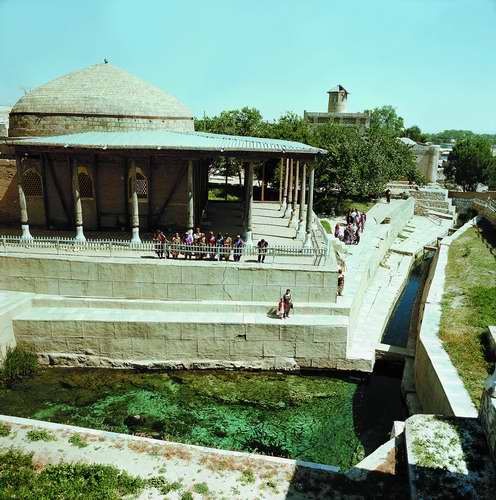Nurata - Sacred Spring in the Steppe

Nurata is home to the Nurata Mountains and is famous for its old circle patterned Suzani which sell for thousands at auctions. Dating back to The Bronze Age, you can see how amazingly historical this place is with so much knowledge to be gained here. Nurata itself owes its life to the so-called kareez, i.e. a combination of surface and underground canals that basically slush water from a spring, lake or ground water to a city or surrounding fields. Thanks to these underground galleries, it was possible to collect melting snow or rain from the nearby mountains in order to turn these arid lands into flourishing oasis. The history doesn't stop there, as there are tenth century mosques and the place where the Chashma – Springs formed. Water temperature in a sacred Nurata source is stable 19, 5 degrees. In water, according to studying of scientists were revealed 15 microelements, particularly: gold, silver, bromine, iodine. Because of presence of silver in water it doesn't spoil even during a long storage. Bromine in turn creates soothing action and favorably influences a human body against diseases of nervous system; also it treats a gastrointestinal tract.
This extensive introduction brings to Alexander as the story goes that he was the one who gave instructions to detour the waters from below the mountains behind Nurata through underground corridors and canals in order to irrigate the fields. This antique system seems to be several kilometers long. In fact, it is a combination of horizontal passages and vertical shafts as clearly explained in this drawing made by the Heritage Institute. Even today, the system is still effectively used by the local population thanks to thorough recent cleaning and restoration. Such an intricate irrigation work is still in working order many thousands of years later as it seems to go back to times from before the Achaemenids Empire. Alexander most probably helped to maintain the system.
Uzbek sources relate that Alexander instructed one of his generals, a certain Farhangi – Sarhang (“Sarhang” means “Officer”), to build a fort. Alexander left for other conquests and when he returned and saw the fort.
Today as in Alexander’s time, the location of this fortress at the southern end of Nurata is a very strategic one, i.e. at the very edge where agricultural land turns into wild steppe. In fact, it was an ideal place for the king to gather his army in formation before attacking neighboring tribes, while in later years it was an ideal refuge for rebels and outcasts. This fortress surrounded by large walls and supporting towers must have looked like a small town with an inner core, the Shahristan, measuring 500x500 meters.








 +99890 979 38 98
+99890 979 38 98 +99871 252 52 32
+99871 252 52 32 +99871 252 61 84
+99871 252 61 84



























